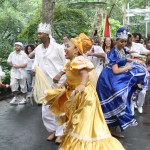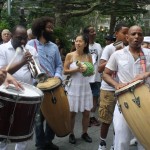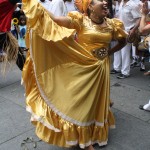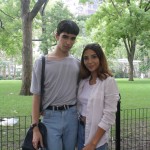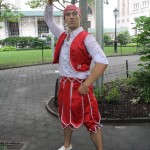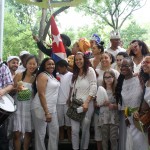Viewpoints
Dia de Reyes: Afro-Cuban Workshop
A handful of children of all races and ages dance off-beat along with their parents to the sound of four men, dressed in white, beating their drums as they sit on benches in Madison Square Park. The scene was part of the first ever Dia de Reyes celebration on July 18th, a free, public Afro-Cuban dance workshop and music performance.
The workshop, taught by musician Rafael Monteagudo and other percussionists, showcased for the gathered audience of children and adults how to play the Bata Drum and Congas. These instruments symbolize the Afro Cuban culture.
“The Bata drums originated in Nigeria and were brought to Cuba centuries ago and the congos were indigenous to Cuba,” said Monteagudo “So the playing of it together represents the Afro-Cuban Culture.”
Dia de Reyes was the only day in Cuba when Africans, free or enslaved, could publicly perform their dances and music. It was a day that represented racial, ethnic, and religious freedom, according Yesenia Selier, the director of the workshop.
“I envision this procession marching freely through Madison Square Park in New York at this decisive moment in time, when American society is updating the state of civil rights for marginalized populations,” Selier posted on the park website.
The event coincides with the annual celebration “Carnaval de Santiago de Cuba”, one of the largest carnivals in Cuba celebrating the day of the patron Saint Santiago from Spain who the Cubans fought for their independence from.
Selier choose Madison Square Park so the event could honor Teresita Fernandez, an Afro Cuban descendant and one of the producers of the event, by traveling through her piece Fata Morgana, a 500 foot-long golden mirage sculpture that hovers over a section of the park.
Six different artist presented informal 15 to 30 minute workshops teaching people percussion, dance, and musical elements that led into a large group procession and performance.
“We just kinda ran across it while walking. We loved the dancing and costumes,” said Jasmine, a passerby who decided to participate in the workshops.
The celebration and performance was more than just a celebration of Afro-Cuban culture and faith, it was also about giving back to the community, according to Hunter Houde, 28, one of the dancers in the event. Selier and Houde also host a Rumba Academy,which provides full summer scholarships to teenagers between 15 and 17 in New York to assist in preserving the culture.
Houde expressed that the event and culture was also a connection to the spirituality practiced by some in Cuba called Santeria.
“The natural forces of the Orishas [the Gods of the Santeria religion] and the traditions of the African culture combined…Its fun, it gives me joy and pleasure.,” said Houde. “It’s important for the country. By dancing, I’m preserving and honoring the culture.”
Helen Ceballos, the event producer, explained that she isn’t Cuban but the Santeria religion and the Cuban culture drew her in.
“I wasn’t born in Cuba, I am Dominican and Puerto Rican,” said Ceballos. “Through the religion and culture and music I found my way here.”
Yesenia Selier describes Dia de Reyes as “A celebration of inclusion, identity, and pride, and an event that preserves the identities of people of African descent in the Americas.”



